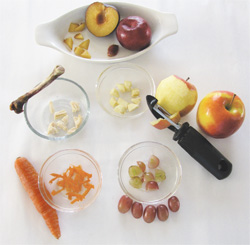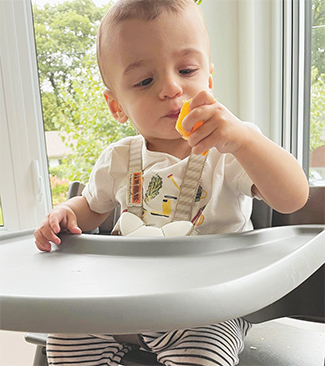Choking risk: Be extra careful until age 4

![]() To prevent choking, be sure to take certain precautions when preparing food.
To prevent choking, be sure to take certain precautions when preparing food.

![]() Belt your child into the high chair so she cannot slide out or climb over the backrest or the tray. This also helps her maintain good posture while eating.
Belt your child into the high chair so she cannot slide out or climb over the backrest or the tray. This also helps her maintain good posture while eating.
![]() For your baby’s safety, keep a close eye on her at all times during a meal.
For your baby’s safety, keep a close eye on her at all times during a meal.
Certain foods can become stuck in your child’s throat or block her airway. Many children choke on food each year.
Foods that are hard, small, round, smooth, or sticky present the greatest risk.
Certain foods require careful preparation. To prevent the risk of choking, be sure to:
- Remove bones from meat and fish
- Remove cores and pits from fruit
- Cut grapes into quarters
- Grate raw hard vegetables and fruits like carrots, turnips, and apples
Toward age 2, you can start giving your child whole apples (peeled) and whole small fruit, except for grapes, which you should continue cutting into quarters.
![]() Certain foods present a choking risk for your child up until the age of 4: peanuts, nuts, seeds, hard candy, cough drops, popcorn, chewing gum, whole grapes, raisins, sliced sausage, raw carrots or celery, food on toothpicks or skewers, ice cubes, etc.
Certain foods present a choking risk for your child up until the age of 4: peanuts, nuts, seeds, hard candy, cough drops, popcorn, chewing gum, whole grapes, raisins, sliced sausage, raw carrots or celery, food on toothpicks or skewers, ice cubes, etc.
Rules to prevent choking
- Make sure your child is always supervised when eating.
- Sit your child in a high chair (see High chair).
- Don’t let your child walk or run with food in her mouth.
- Avoid feeding your child in the car.
- Keep dangerous foods out of reach.
Ask older children to follow these rules.
A first aid course will teach you what to do if your child is choking (see Choking).


